Network Design and Addressing Solution: TCP/IP Internetworking Case
VerifiedAdded on 2023/06/14
|12
|2089
|500
Case Study
AI Summary
This document presents a case study focusing on TCP/IP internetworking for Foreshore IT Solutions, detailing the design and implementation of a network divided into six sub-networks. The solution includes a network topology diagram, an addressing scheme to accommodate 1200 workstations across various departments (Finance Office, IT Call Centre, Finance Department, Marketing Department, Information Technology Department, and Head Office), and a justification for the chosen network configuration. The case study addresses subnet mask calculations, host address ranges, and broadcast address calculations using the Address Resolution Protocol (ARP). It further discusses the implications of scaling the network beyond 1024 hosts per building and provides alternative addressing solutions. The study concludes by emphasizing the importance of network design for organizational communication and provides recommendations for future network expansions. Desklib offers a wealth of similar solved assignments and past papers for students.
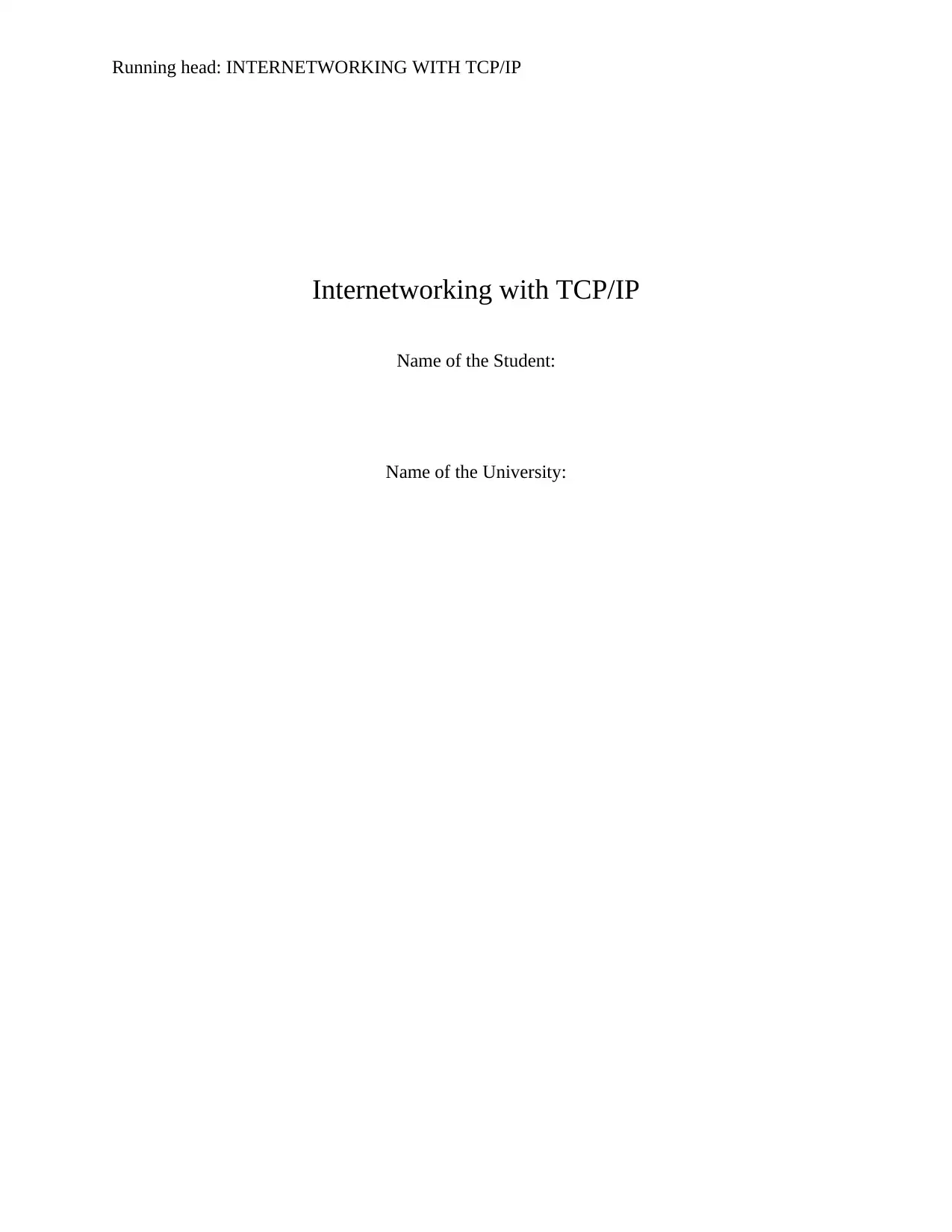
Running head: INTERNETWORKING WITH TCP/IP
Internetworking with TCP/IP
Name of the Student:
Name of the University:
Internetworking with TCP/IP
Name of the Student:
Name of the University:
Paraphrase This Document
Need a fresh take? Get an instant paraphrase of this document with our AI Paraphraser
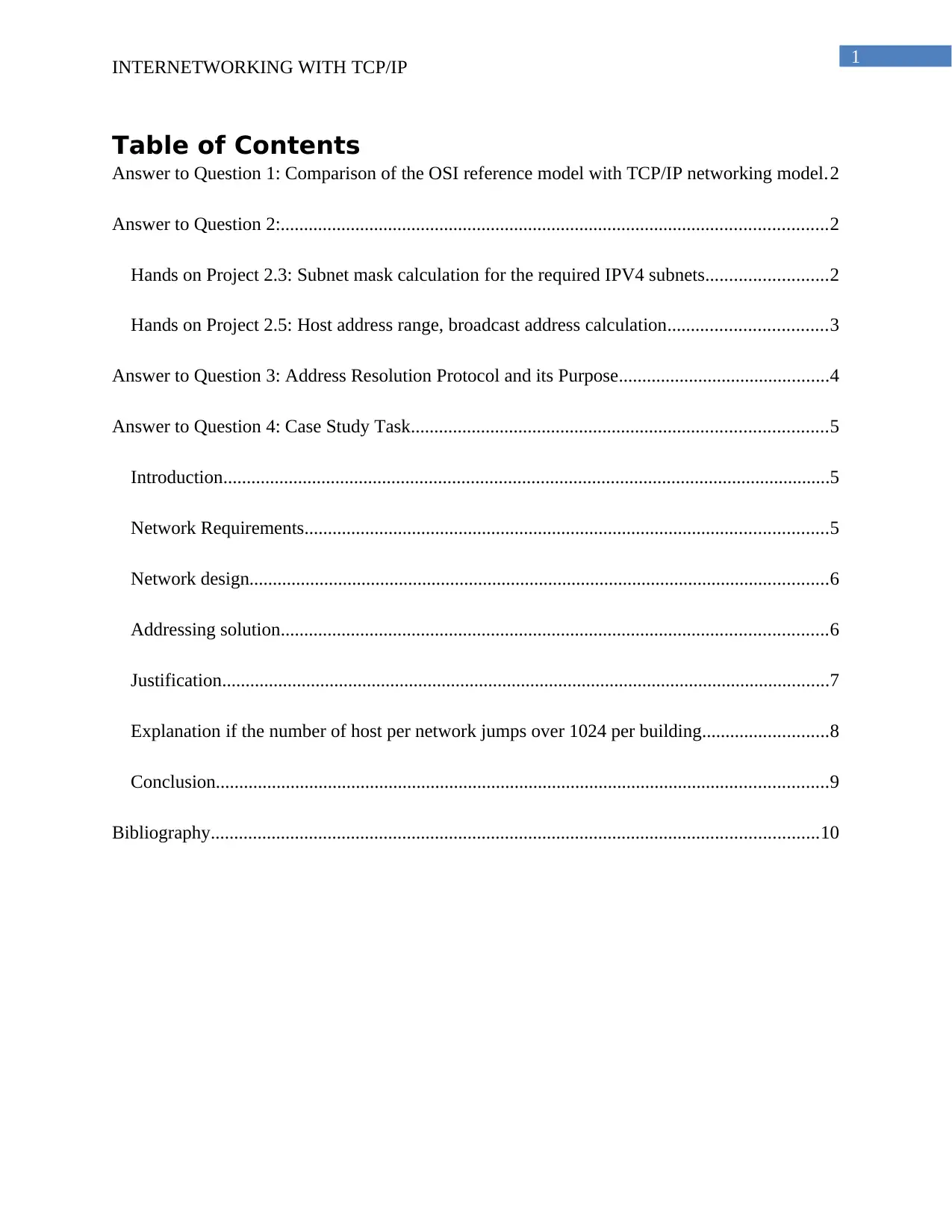
1
INTERNETWORKING WITH TCP/IP
Table of Contents
Answer to Question 1: Comparison of the OSI reference model with TCP/IP networking model.2
Answer to Question 2:.....................................................................................................................2
Hands on Project 2.3: Subnet mask calculation for the required IPV4 subnets..........................2
Hands on Project 2.5: Host address range, broadcast address calculation..................................3
Answer to Question 3: Address Resolution Protocol and its Purpose.............................................4
Answer to Question 4: Case Study Task.........................................................................................5
Introduction..................................................................................................................................5
Network Requirements................................................................................................................5
Network design............................................................................................................................6
Addressing solution.....................................................................................................................6
Justification..................................................................................................................................7
Explanation if the number of host per network jumps over 1024 per building...........................8
Conclusion...................................................................................................................................9
Bibliography..................................................................................................................................10
INTERNETWORKING WITH TCP/IP
Table of Contents
Answer to Question 1: Comparison of the OSI reference model with TCP/IP networking model.2
Answer to Question 2:.....................................................................................................................2
Hands on Project 2.3: Subnet mask calculation for the required IPV4 subnets..........................2
Hands on Project 2.5: Host address range, broadcast address calculation..................................3
Answer to Question 3: Address Resolution Protocol and its Purpose.............................................4
Answer to Question 4: Case Study Task.........................................................................................5
Introduction..................................................................................................................................5
Network Requirements................................................................................................................5
Network design............................................................................................................................6
Addressing solution.....................................................................................................................6
Justification..................................................................................................................................7
Explanation if the number of host per network jumps over 1024 per building...........................8
Conclusion...................................................................................................................................9
Bibliography..................................................................................................................................10
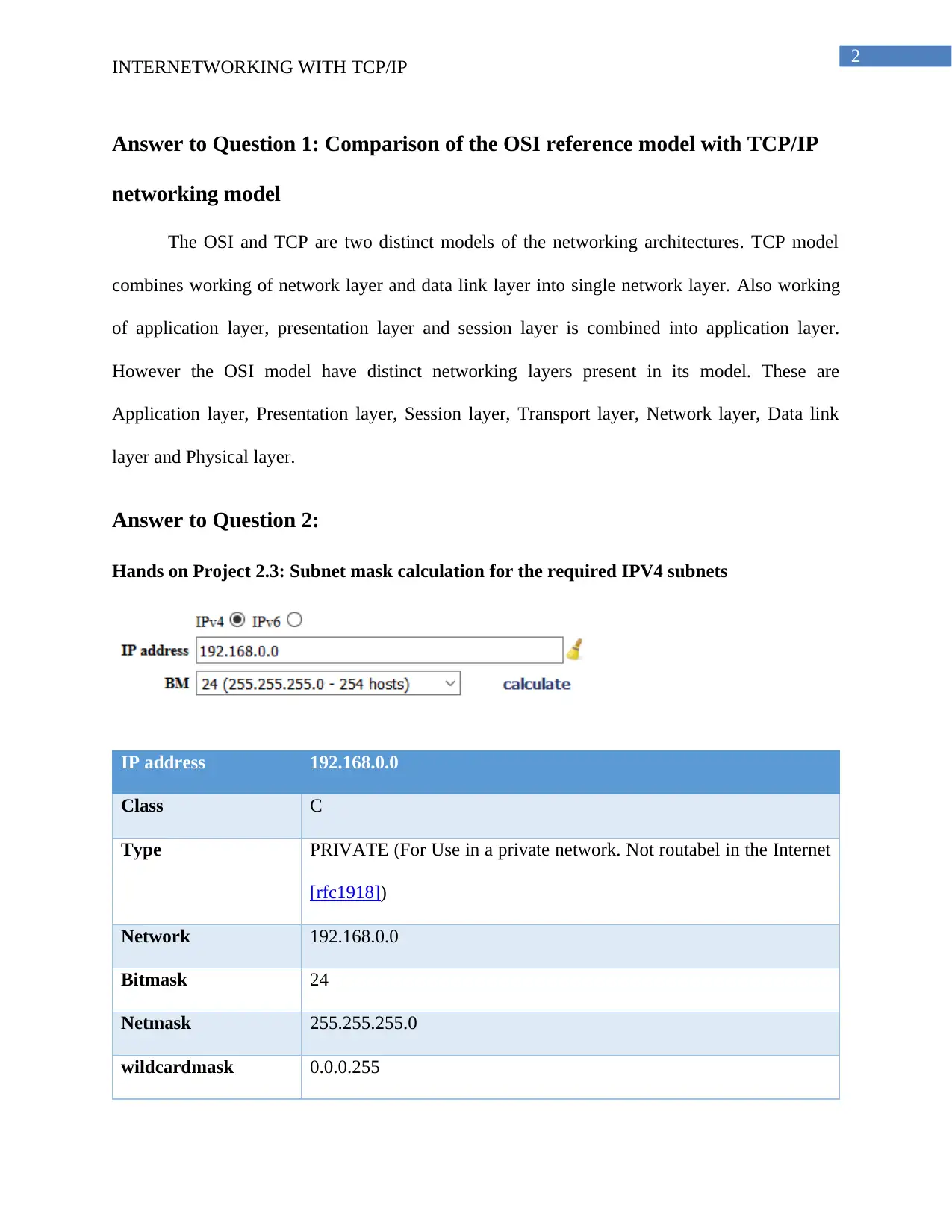
2
INTERNETWORKING WITH TCP/IP
Answer to Question 1: Comparison of the OSI reference model with TCP/IP
networking model
The OSI and TCP are two distinct models of the networking architectures. TCP model
combines working of network layer and data link layer into single network layer. Also working
of application layer, presentation layer and session layer is combined into application layer.
However the OSI model have distinct networking layers present in its model. These are
Application layer, Presentation layer, Session layer, Transport layer, Network layer, Data link
layer and Physical layer.
Answer to Question 2:
Hands on Project 2.3: Subnet mask calculation for the required IPV4 subnets
IP address 192.168.0.0
Class C
Type PRIVATE (For Use in a private network. Not routabel in the Internet
[rfc1918])
Network 192.168.0.0
Bitmask 24
Netmask 255.255.255.0
wildcardmask 0.0.0.255
INTERNETWORKING WITH TCP/IP
Answer to Question 1: Comparison of the OSI reference model with TCP/IP
networking model
The OSI and TCP are two distinct models of the networking architectures. TCP model
combines working of network layer and data link layer into single network layer. Also working
of application layer, presentation layer and session layer is combined into application layer.
However the OSI model have distinct networking layers present in its model. These are
Application layer, Presentation layer, Session layer, Transport layer, Network layer, Data link
layer and Physical layer.
Answer to Question 2:
Hands on Project 2.3: Subnet mask calculation for the required IPV4 subnets
IP address 192.168.0.0
Class C
Type PRIVATE (For Use in a private network. Not routabel in the Internet
[rfc1918])
Network 192.168.0.0
Bitmask 24
Netmask 255.255.255.0
wildcardmask 0.0.0.255
⊘ This is a preview!⊘
Do you want full access?
Subscribe today to unlock all pages.

Trusted by 1+ million students worldwide
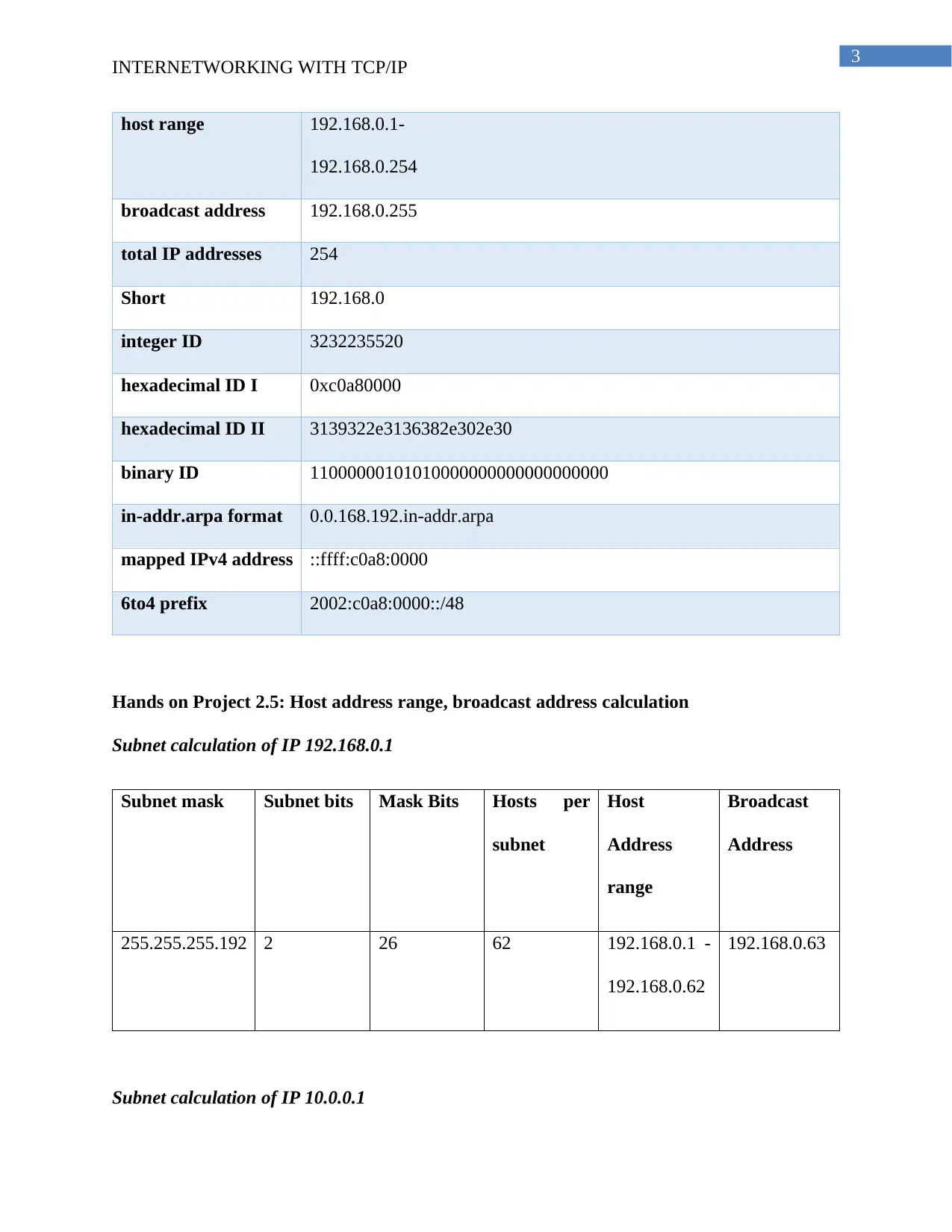
3
INTERNETWORKING WITH TCP/IP
host range 192.168.0.1-
192.168.0.254
broadcast address 192.168.0.255
total IP addresses 254
Short 192.168.0
integer ID 3232235520
hexadecimal ID I 0xc0a80000
hexadecimal ID II 3139322e3136382e302e30
binary ID 11000000101010000000000000000000
in-addr.arpa format 0.0.168.192.in-addr.arpa
mapped IPv4 address ::ffff:c0a8:0000
6to4 prefix 2002:c0a8:0000::/48
Hands on Project 2.5: Host address range, broadcast address calculation
Subnet calculation of IP 192.168.0.1
Subnet mask Subnet bits Mask Bits Hosts per
subnet
Host
Address
range
Broadcast
Address
255.255.255.192 2 26 62 192.168.0.1 -
192.168.0.62
192.168.0.63
Subnet calculation of IP 10.0.0.1
INTERNETWORKING WITH TCP/IP
host range 192.168.0.1-
192.168.0.254
broadcast address 192.168.0.255
total IP addresses 254
Short 192.168.0
integer ID 3232235520
hexadecimal ID I 0xc0a80000
hexadecimal ID II 3139322e3136382e302e30
binary ID 11000000101010000000000000000000
in-addr.arpa format 0.0.168.192.in-addr.arpa
mapped IPv4 address ::ffff:c0a8:0000
6to4 prefix 2002:c0a8:0000::/48
Hands on Project 2.5: Host address range, broadcast address calculation
Subnet calculation of IP 192.168.0.1
Subnet mask Subnet bits Mask Bits Hosts per
subnet
Host
Address
range
Broadcast
Address
255.255.255.192 2 26 62 192.168.0.1 -
192.168.0.62
192.168.0.63
Subnet calculation of IP 10.0.0.1
Paraphrase This Document
Need a fresh take? Get an instant paraphrase of this document with our AI Paraphraser

4
INTERNETWORKING WITH TCP/IP
Subnet bits Maximum
subnets
Mask Bits Hosts per
subnet
Host
Address
range
Broadcast
Address
8 256 16 65534 10.0.0.1 -
10.0.255.254
10.0.255.255
Answer to Question 3: Address Resolution Protocol and its Purpose
Address Resolution protocol (ARP) –
The ARP or Address Resolution protocol is used in the second layer of the data link
layer. It is used to find the MAC address of a machine in LAN whose IP address is known. As in
Data Link Layer IP addresses are not much useful MAC addresses are used for communication
within a LAN. To send a datagram, the physical/link layers can only use physical addresses.
They know nothing of IP. But the transport layer knows nothing about MACs, so the ARP
protocol performs a translation service to allow the link layer to find an address in it’s domain
for an address given in a different domain.
Purpose of ARP Cache
ARP cache is basically a table that holds the information of the MAC address that are
mapped to the IP addresses recently. When machine looks to broadcast a message to the machine
that connected to it recently, it looks for the currently used MAC addresses in the ARP cache.
Hence this table makes the process of searching for an answer much faster and increases the
efficiency of the network as a result.
INTERNETWORKING WITH TCP/IP
Subnet bits Maximum
subnets
Mask Bits Hosts per
subnet
Host
Address
range
Broadcast
Address
8 256 16 65534 10.0.0.1 -
10.0.255.254
10.0.255.255
Answer to Question 3: Address Resolution Protocol and its Purpose
Address Resolution protocol (ARP) –
The ARP or Address Resolution protocol is used in the second layer of the data link
layer. It is used to find the MAC address of a machine in LAN whose IP address is known. As in
Data Link Layer IP addresses are not much useful MAC addresses are used for communication
within a LAN. To send a datagram, the physical/link layers can only use physical addresses.
They know nothing of IP. But the transport layer knows nothing about MACs, so the ARP
protocol performs a translation service to allow the link layer to find an address in it’s domain
for an address given in a different domain.
Purpose of ARP Cache
ARP cache is basically a table that holds the information of the MAC address that are
mapped to the IP addresses recently. When machine looks to broadcast a message to the machine
that connected to it recently, it looks for the currently used MAC addresses in the ARP cache.
Hence this table makes the process of searching for an answer much faster and increases the
efficiency of the network as a result.
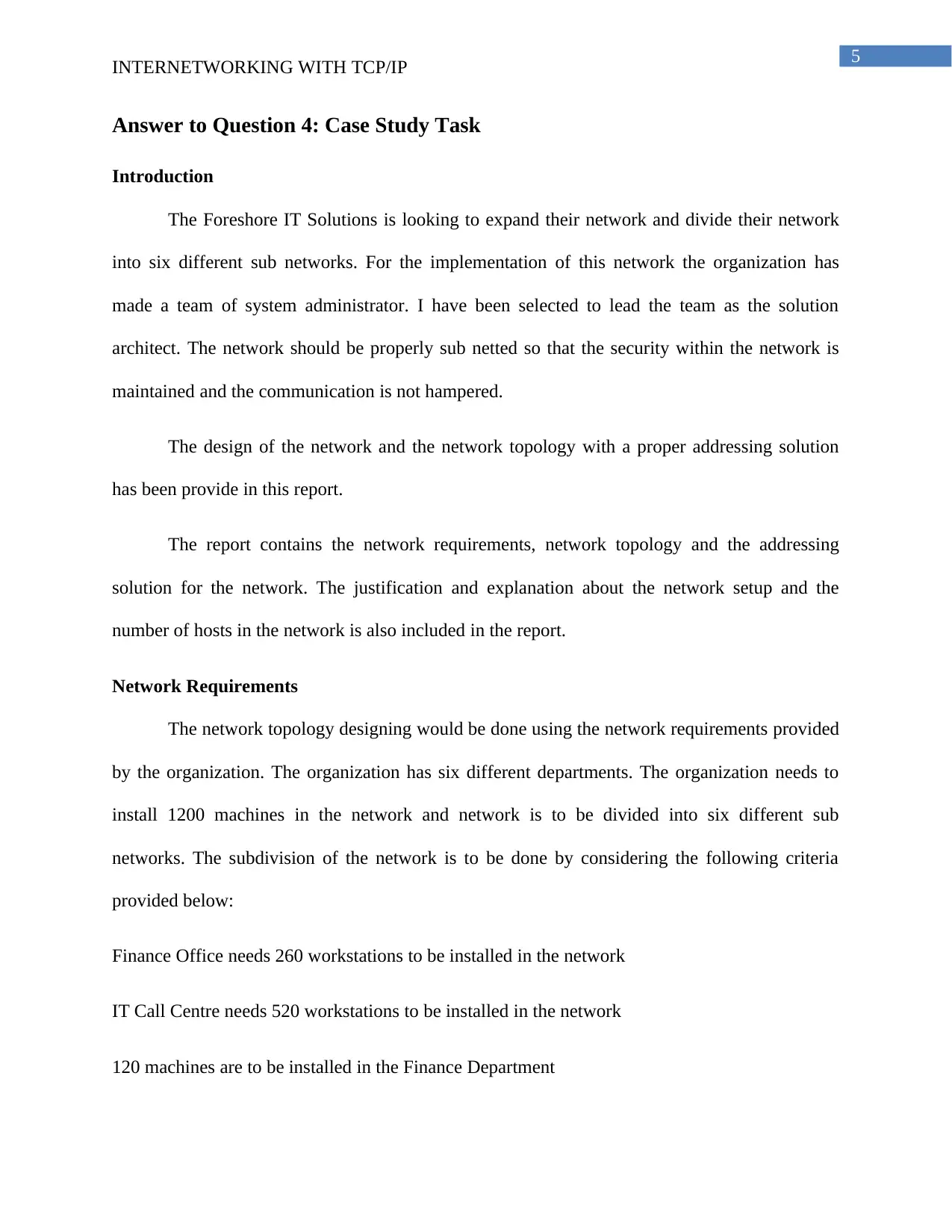
5
INTERNETWORKING WITH TCP/IP
Answer to Question 4: Case Study Task
Introduction
The Foreshore IT Solutions is looking to expand their network and divide their network
into six different sub networks. For the implementation of this network the organization has
made a team of system administrator. I have been selected to lead the team as the solution
architect. The network should be properly sub netted so that the security within the network is
maintained and the communication is not hampered.
The design of the network and the network topology with a proper addressing solution
has been provide in this report.
The report contains the network requirements, network topology and the addressing
solution for the network. The justification and explanation about the network setup and the
number of hosts in the network is also included in the report.
Network Requirements
The network topology designing would be done using the network requirements provided
by the organization. The organization has six different departments. The organization needs to
install 1200 machines in the network and network is to be divided into six different sub
networks. The subdivision of the network is to be done by considering the following criteria
provided below:
Finance Office needs 260 workstations to be installed in the network
IT Call Centre needs 520 workstations to be installed in the network
120 machines are to be installed in the Finance Department
INTERNETWORKING WITH TCP/IP
Answer to Question 4: Case Study Task
Introduction
The Foreshore IT Solutions is looking to expand their network and divide their network
into six different sub networks. For the implementation of this network the organization has
made a team of system administrator. I have been selected to lead the team as the solution
architect. The network should be properly sub netted so that the security within the network is
maintained and the communication is not hampered.
The design of the network and the network topology with a proper addressing solution
has been provide in this report.
The report contains the network requirements, network topology and the addressing
solution for the network. The justification and explanation about the network setup and the
number of hosts in the network is also included in the report.
Network Requirements
The network topology designing would be done using the network requirements provided
by the organization. The organization has six different departments. The organization needs to
install 1200 machines in the network and network is to be divided into six different sub
networks. The subdivision of the network is to be done by considering the following criteria
provided below:
Finance Office needs 260 workstations to be installed in the network
IT Call Centre needs 520 workstations to be installed in the network
120 machines are to be installed in the Finance Department
⊘ This is a preview!⊘
Do you want full access?
Subscribe today to unlock all pages.

Trusted by 1+ million students worldwide
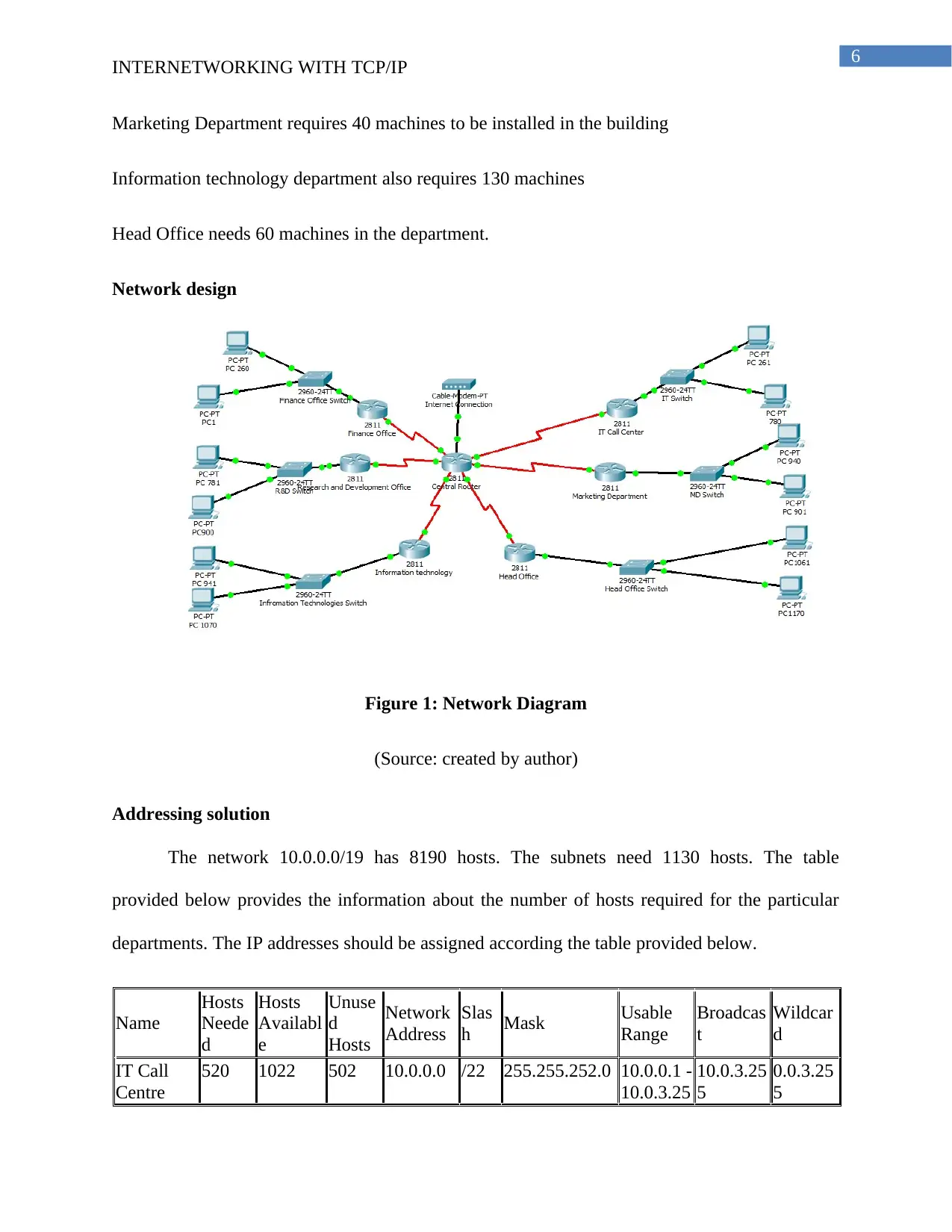
6
INTERNETWORKING WITH TCP/IP
Marketing Department requires 40 machines to be installed in the building
Information technology department also requires 130 machines
Head Office needs 60 machines in the department.
Network design
Figure 1: Network Diagram
(Source: created by author)
Addressing solution
The network 10.0.0.0/19 has 8190 hosts. The subnets need 1130 hosts. The table
provided below provides the information about the number of hosts required for the particular
departments. The IP addresses should be assigned according the table provided below.
Name
Hosts
Neede
d
Hosts
Availabl
e
Unuse
d
Hosts
Network
Address
Slas
h Mask Usable
Range
Broadcas
t
Wildcar
d
IT Call
Centre
520 1022 502 10.0.0.0 /22 255.255.252.0 10.0.0.1 -
10.0.3.25
10.0.3.25
5
0.0.3.25
5
INTERNETWORKING WITH TCP/IP
Marketing Department requires 40 machines to be installed in the building
Information technology department also requires 130 machines
Head Office needs 60 machines in the department.
Network design
Figure 1: Network Diagram
(Source: created by author)
Addressing solution
The network 10.0.0.0/19 has 8190 hosts. The subnets need 1130 hosts. The table
provided below provides the information about the number of hosts required for the particular
departments. The IP addresses should be assigned according the table provided below.
Name
Hosts
Neede
d
Hosts
Availabl
e
Unuse
d
Hosts
Network
Address
Slas
h Mask Usable
Range
Broadcas
t
Wildcar
d
IT Call
Centre
520 1022 502 10.0.0.0 /22 255.255.252.0 10.0.0.1 -
10.0.3.25
10.0.3.25
5
0.0.3.25
5
Paraphrase This Document
Need a fresh take? Get an instant paraphrase of this document with our AI Paraphraser
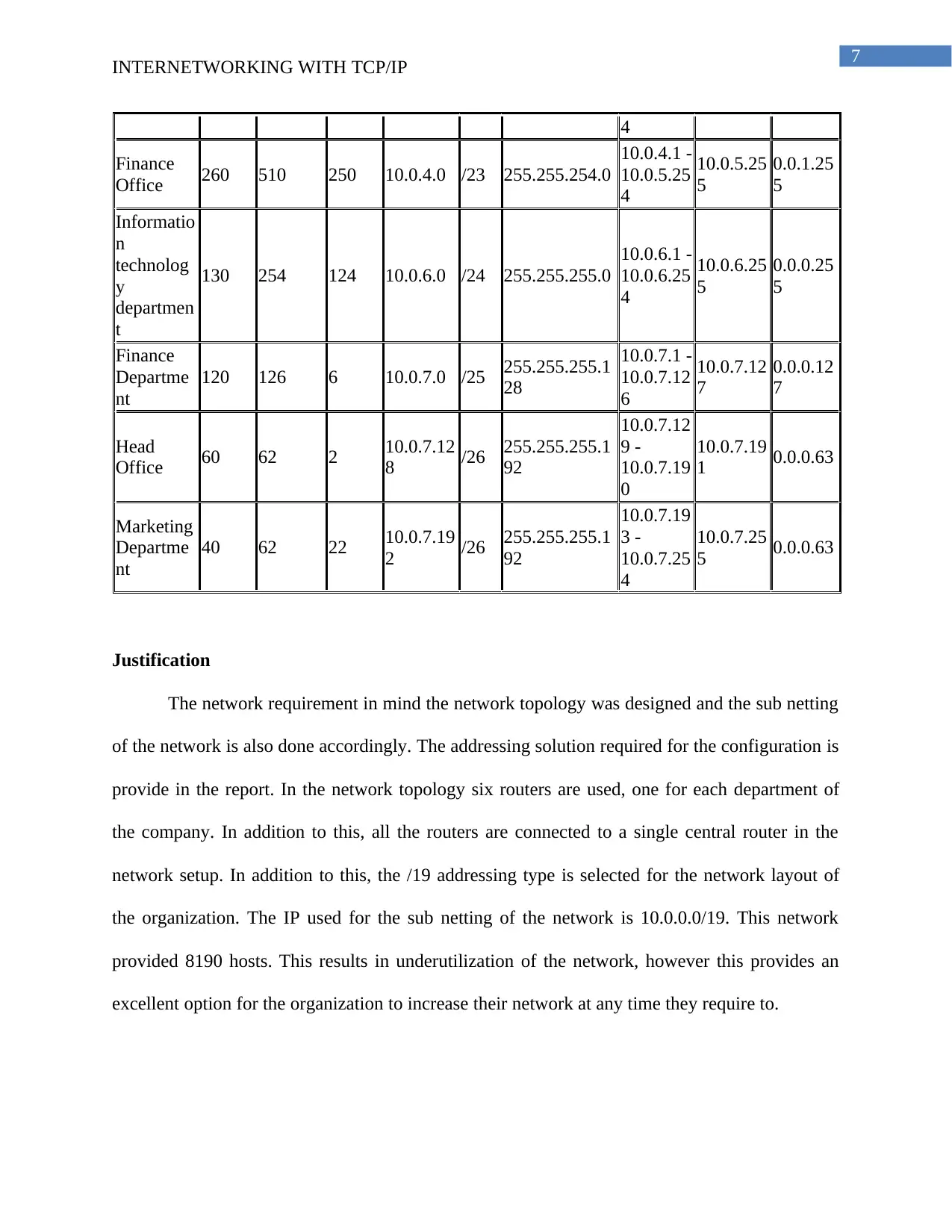
7
INTERNETWORKING WITH TCP/IP
4
Finance
Office 260 510 250 10.0.4.0 /23 255.255.254.0
10.0.4.1 -
10.0.5.25
4
10.0.5.25
5
0.0.1.25
5
Informatio
n
technolog
y
departmen
t
130 254 124 10.0.6.0 /24 255.255.255.0
10.0.6.1 -
10.0.6.25
4
10.0.6.25
5
0.0.0.25
5
Finance
Departme
nt
120 126 6 10.0.7.0 /25 255.255.255.1
28
10.0.7.1 -
10.0.7.12
6
10.0.7.12
7
0.0.0.12
7
Head
Office 60 62 2 10.0.7.12
8 /26 255.255.255.1
92
10.0.7.12
9 -
10.0.7.19
0
10.0.7.19
1 0.0.0.63
Marketing
Departme
nt
40 62 22 10.0.7.19
2 /26 255.255.255.1
92
10.0.7.19
3 -
10.0.7.25
4
10.0.7.25
5 0.0.0.63
Justification
The network requirement in mind the network topology was designed and the sub netting
of the network is also done accordingly. The addressing solution required for the configuration is
provide in the report. In the network topology six routers are used, one for each department of
the company. In addition to this, all the routers are connected to a single central router in the
network setup. In addition to this, the /19 addressing type is selected for the network layout of
the organization. The IP used for the sub netting of the network is 10.0.0.0/19. This network
provided 8190 hosts. This results in underutilization of the network, however this provides an
excellent option for the organization to increase their network at any time they require to.
INTERNETWORKING WITH TCP/IP
4
Finance
Office 260 510 250 10.0.4.0 /23 255.255.254.0
10.0.4.1 -
10.0.5.25
4
10.0.5.25
5
0.0.1.25
5
Informatio
n
technolog
y
departmen
t
130 254 124 10.0.6.0 /24 255.255.255.0
10.0.6.1 -
10.0.6.25
4
10.0.6.25
5
0.0.0.25
5
Finance
Departme
nt
120 126 6 10.0.7.0 /25 255.255.255.1
28
10.0.7.1 -
10.0.7.12
6
10.0.7.12
7
0.0.0.12
7
Head
Office 60 62 2 10.0.7.12
8 /26 255.255.255.1
92
10.0.7.12
9 -
10.0.7.19
0
10.0.7.19
1 0.0.0.63
Marketing
Departme
nt
40 62 22 10.0.7.19
2 /26 255.255.255.1
92
10.0.7.19
3 -
10.0.7.25
4
10.0.7.25
5 0.0.0.63
Justification
The network requirement in mind the network topology was designed and the sub netting
of the network is also done accordingly. The addressing solution required for the configuration is
provide in the report. In the network topology six routers are used, one for each department of
the company. In addition to this, all the routers are connected to a single central router in the
network setup. In addition to this, the /19 addressing type is selected for the network layout of
the organization. The IP used for the sub netting of the network is 10.0.0.0/19. This network
provided 8190 hosts. This results in underutilization of the network, however this provides an
excellent option for the organization to increase their network at any time they require to.
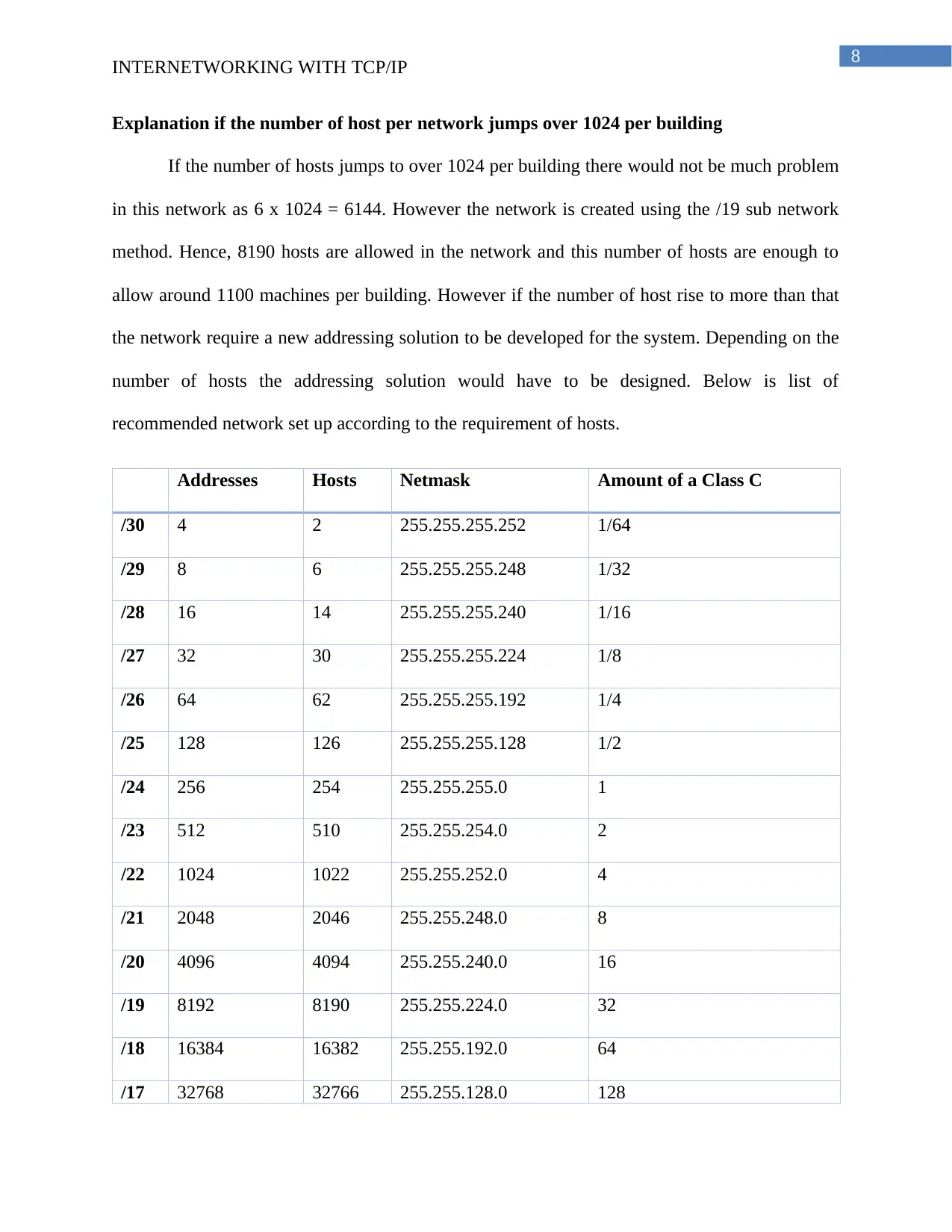
8
INTERNETWORKING WITH TCP/IP
Explanation if the number of host per network jumps over 1024 per building
If the number of hosts jumps to over 1024 per building there would not be much problem
in this network as 6 x 1024 = 6144. However the network is created using the /19 sub network
method. Hence, 8190 hosts are allowed in the network and this number of hosts are enough to
allow around 1100 machines per building. However if the number of host rise to more than that
the network require a new addressing solution to be developed for the system. Depending on the
number of hosts the addressing solution would have to be designed. Below is list of
recommended network set up according to the requirement of hosts.
Addresses Hosts Netmask Amount of a Class C
/30 4 2 255.255.255.252 1/64
/29 8 6 255.255.255.248 1/32
/28 16 14 255.255.255.240 1/16
/27 32 30 255.255.255.224 1/8
/26 64 62 255.255.255.192 1/4
/25 128 126 255.255.255.128 1/2
/24 256 254 255.255.255.0 1
/23 512 510 255.255.254.0 2
/22 1024 1022 255.255.252.0 4
/21 2048 2046 255.255.248.0 8
/20 4096 4094 255.255.240.0 16
/19 8192 8190 255.255.224.0 32
/18 16384 16382 255.255.192.0 64
/17 32768 32766 255.255.128.0 128
INTERNETWORKING WITH TCP/IP
Explanation if the number of host per network jumps over 1024 per building
If the number of hosts jumps to over 1024 per building there would not be much problem
in this network as 6 x 1024 = 6144. However the network is created using the /19 sub network
method. Hence, 8190 hosts are allowed in the network and this number of hosts are enough to
allow around 1100 machines per building. However if the number of host rise to more than that
the network require a new addressing solution to be developed for the system. Depending on the
number of hosts the addressing solution would have to be designed. Below is list of
recommended network set up according to the requirement of hosts.
Addresses Hosts Netmask Amount of a Class C
/30 4 2 255.255.255.252 1/64
/29 8 6 255.255.255.248 1/32
/28 16 14 255.255.255.240 1/16
/27 32 30 255.255.255.224 1/8
/26 64 62 255.255.255.192 1/4
/25 128 126 255.255.255.128 1/2
/24 256 254 255.255.255.0 1
/23 512 510 255.255.254.0 2
/22 1024 1022 255.255.252.0 4
/21 2048 2046 255.255.248.0 8
/20 4096 4094 255.255.240.0 16
/19 8192 8190 255.255.224.0 32
/18 16384 16382 255.255.192.0 64
/17 32768 32766 255.255.128.0 128
⊘ This is a preview!⊘
Do you want full access?
Subscribe today to unlock all pages.

Trusted by 1+ million students worldwide

9
INTERNETWORKING WITH TCP/IP
/16 65536 65534 255.255.0.0 256
In addition to this, the network would require different class of addressing if the number
of hosts for the network are higher.
Conclusion
For conclusion it can be said that network design and architecture is very important for
any type of organization. The network set up helps all the peripherals of the organization to be
interconnected with each other and the hence this is very important for the communication within
the organization. The Foreshore IT Solutions is also looking to implement such a network and
the solution for the network of the organization have been described in this network. The
network would an efficient one if the network is laid with the provided solution. Proper
justification for the selection of /19 network and selection of network topology have been
provided in this report. In addition to this recommendations are also provided for the
organization in case the number of hosts in the network are increased to a greater extent.
INTERNETWORKING WITH TCP/IP
/16 65536 65534 255.255.0.0 256
In addition to this, the network would require different class of addressing if the number
of hosts for the network are higher.
Conclusion
For conclusion it can be said that network design and architecture is very important for
any type of organization. The network set up helps all the peripherals of the organization to be
interconnected with each other and the hence this is very important for the communication within
the organization. The Foreshore IT Solutions is also looking to implement such a network and
the solution for the network of the organization have been described in this network. The
network would an efficient one if the network is laid with the provided solution. Proper
justification for the selection of /19 network and selection of network topology have been
provided in this report. In addition to this recommendations are also provided for the
organization in case the number of hosts in the network are increased to a greater extent.
Paraphrase This Document
Need a fresh take? Get an instant paraphrase of this document with our AI Paraphraser

10
INTERNETWORKING WITH TCP/IP
Bibliography
Bruschi, D., Di Pasquale, A., Ghilardi, S., Lanzi, A., & Pagani, E. (2017, September). Formal
Verification of ARP (Address Resolution Protocol) Through SMT-Based Model
Checking-A Case Study. In International Conference on Integrated Formal Methods (pp.
391-406). Springer, Cham.
Comer, D. (2014). Fundamentals Of Computer Networking And Internetworking.
Edwards, J., & Bramante, R. (2015). Networking self-teaching guide: OSI, TCP/IP, LANs,
MANs, WANs, implementation, management, and maintenance. John Wiley & Sons.
Grasa, E., Bergesio, L., Tarzan, M., Trouva, E., Gaston, B., Salvestrini, F., ... & Colle, D. (2016).
Recursive InterNetwork Architecture, Investigating RINA as an Alternative to TCP/IP
(IRATI). In Building the Future Internet through FIRE (pp. 491-520).
Hua, Y. (2016, April). Cheetah: An efficient flat addressing scheme for fast query services in
cloud computing. In INFOCOM 2016-The 35th Annual IEEE International Conference
on Computer Communications, IEEE (pp. 1-9). IEEE.
IPv4/IPv6 subnet calculator and addressing planner. (2018). Gestioip.net. Retrieved 24 March
2018, from http://www.gestioip.net/cgi-bin/subnet_calculator.cgi
Kizza, J. M. (2017). Guide to computer network security. Springer.
Ma, C., Xie, Y., Chen, H., Deng, Y., & Yan, W. (2014, May). Simplified addressing scheme for
mixed radix FFT algorithms. In Acoustics, Speech and Signal Processing (ICASSP),
2014 IEEE International Conference on (pp. 8355-8359). IEEE.
INTERNETWORKING WITH TCP/IP
Bibliography
Bruschi, D., Di Pasquale, A., Ghilardi, S., Lanzi, A., & Pagani, E. (2017, September). Formal
Verification of ARP (Address Resolution Protocol) Through SMT-Based Model
Checking-A Case Study. In International Conference on Integrated Formal Methods (pp.
391-406). Springer, Cham.
Comer, D. (2014). Fundamentals Of Computer Networking And Internetworking.
Edwards, J., & Bramante, R. (2015). Networking self-teaching guide: OSI, TCP/IP, LANs,
MANs, WANs, implementation, management, and maintenance. John Wiley & Sons.
Grasa, E., Bergesio, L., Tarzan, M., Trouva, E., Gaston, B., Salvestrini, F., ... & Colle, D. (2016).
Recursive InterNetwork Architecture, Investigating RINA as an Alternative to TCP/IP
(IRATI). In Building the Future Internet through FIRE (pp. 491-520).
Hua, Y. (2016, April). Cheetah: An efficient flat addressing scheme for fast query services in
cloud computing. In INFOCOM 2016-The 35th Annual IEEE International Conference
on Computer Communications, IEEE (pp. 1-9). IEEE.
IPv4/IPv6 subnet calculator and addressing planner. (2018). Gestioip.net. Retrieved 24 March
2018, from http://www.gestioip.net/cgi-bin/subnet_calculator.cgi
Kizza, J. M. (2017). Guide to computer network security. Springer.
Ma, C., Xie, Y., Chen, H., Deng, Y., & Yan, W. (2014, May). Simplified addressing scheme for
mixed radix FFT algorithms. In Acoustics, Speech and Signal Processing (ICASSP),
2014 IEEE International Conference on (pp. 8355-8359). IEEE.
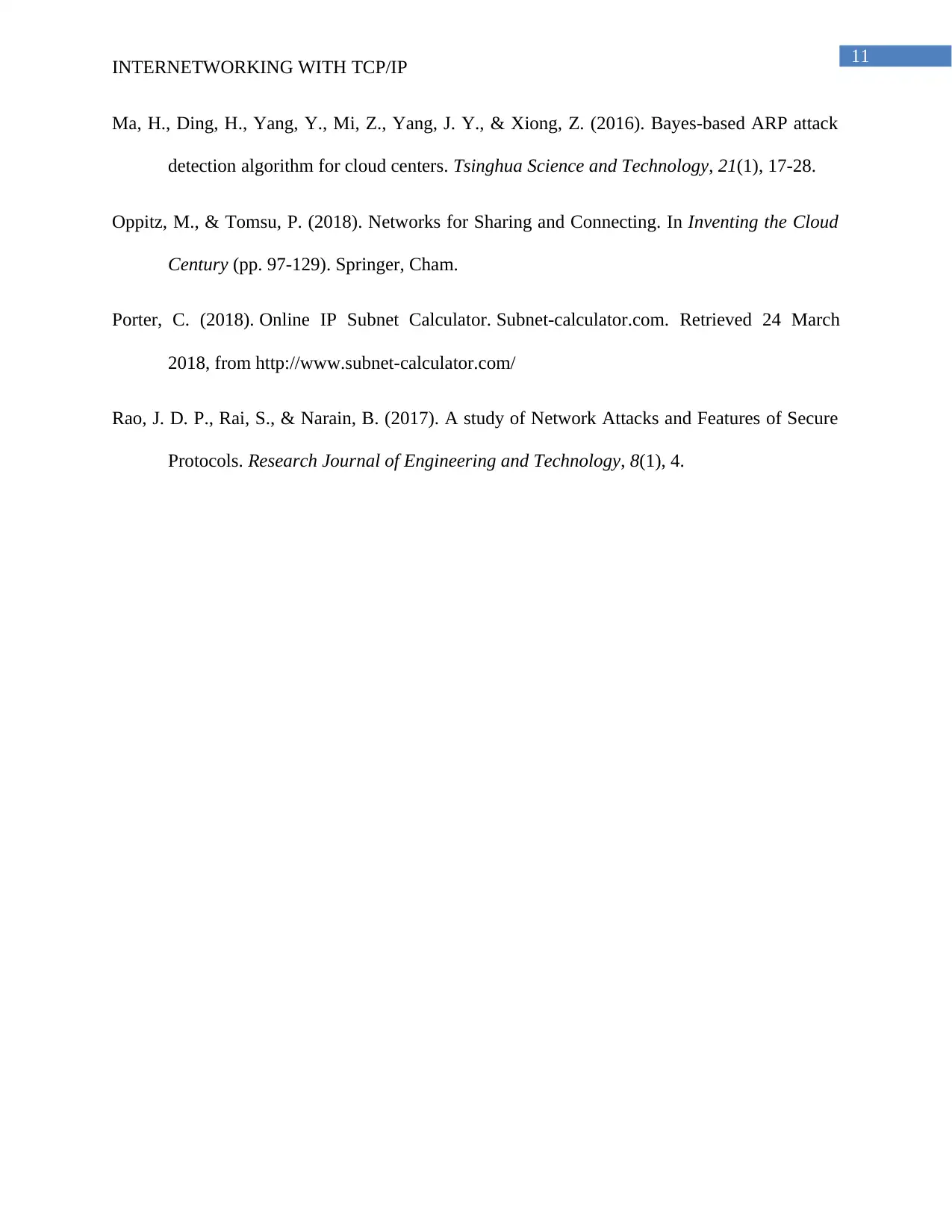
11
INTERNETWORKING WITH TCP/IP
Ma, H., Ding, H., Yang, Y., Mi, Z., Yang, J. Y., & Xiong, Z. (2016). Bayes-based ARP attack
detection algorithm for cloud centers. Tsinghua Science and Technology, 21(1), 17-28.
Oppitz, M., & Tomsu, P. (2018). Networks for Sharing and Connecting. In Inventing the Cloud
Century (pp. 97-129). Springer, Cham.
Porter, C. (2018). Online IP Subnet Calculator. Subnet-calculator.com. Retrieved 24 March
2018, from http://www.subnet-calculator.com/
Rao, J. D. P., Rai, S., & Narain, B. (2017). A study of Network Attacks and Features of Secure
Protocols. Research Journal of Engineering and Technology, 8(1), 4.
INTERNETWORKING WITH TCP/IP
Ma, H., Ding, H., Yang, Y., Mi, Z., Yang, J. Y., & Xiong, Z. (2016). Bayes-based ARP attack
detection algorithm for cloud centers. Tsinghua Science and Technology, 21(1), 17-28.
Oppitz, M., & Tomsu, P. (2018). Networks for Sharing and Connecting. In Inventing the Cloud
Century (pp. 97-129). Springer, Cham.
Porter, C. (2018). Online IP Subnet Calculator. Subnet-calculator.com. Retrieved 24 March
2018, from http://www.subnet-calculator.com/
Rao, J. D. P., Rai, S., & Narain, B. (2017). A study of Network Attacks and Features of Secure
Protocols. Research Journal of Engineering and Technology, 8(1), 4.
⊘ This is a preview!⊘
Do you want full access?
Subscribe today to unlock all pages.

Trusted by 1+ million students worldwide
1 out of 12
Related Documents
Your All-in-One AI-Powered Toolkit for Academic Success.
+13062052269
info@desklib.com
Available 24*7 on WhatsApp / Email
![[object Object]](/_next/static/media/star-bottom.7253800d.svg)
Unlock your academic potential
Copyright © 2020–2025 A2Z Services. All Rights Reserved. Developed and managed by ZUCOL.



